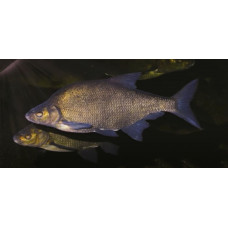The bream (Abramis brama) is a fish of the carp family. It inhabits water bodies of Europe, Asia, and the Caucasus. It is characterized by a high, compressed from the sides of the body. There is a keel behind the pelvic fin. Freshwater and semi-passable fish. Reaches 50 cm and a weight of 3-4.5 kg. Life expectancy is 20 years. Sexual maturity is reached in the third or fourth year of life, in northern waters - in 5-8 years. Spawning is annual. Spawning bream occurs in May-June when the water warms up to 13-15 ° C, at a depth of up to 1 meter. Eggs are sticky, hatched on last year and vegetating flooded aquatic vegetation. Fecundity is from 23 to 274 thousand eggs. It feeds on benthic organisms and vegetation. Acclimatized in water bodies of Siberia. Known in Ubinsky Lake, Balkhash, reservoirs - Novosibirsk, Krasnoyarsk, Bratsk, Ob, Yenisei and many other rivers. A valuable object of fishing.
The body is tall, with a maximum height of about a third of the body length. The head and mouth are small. The mouth ends in a tube that can be extended. The dorsal fin is tall and short with three stiff, non-branched rays and 8-10 soft, branched rays. The anal fin is long with three stiff and 22-29 soft rays, beginning behind the posterior edge of the base of the dorsal fin. There is an unscaled keel between the pelvic fins and the anal fin. The pharyngeal teeth are single row, five on each side. In adult bream back gray or brown, sides golden brown, belly yellowish, all fins are gray, often with dark edges. Young individuals have silver coloration. Maximum body length is 82 cm, weight is 6 kg, maximum life expectancy is 23 years.
The bream keeps in groups, mainly in deep places overgrown with plants. It is cautious and quite intelligent. The convex shape of the mouth is ideal for searching for food in soft mud. The larvae feed on zooplankton. Fry after reaching a length of 30 mm switch to feeding on benthos. It feeds on insect larvae, tubeworms, barnacles and snails. It can also eat algae. Bream may gather in large flocks, especially in large lakes or on strong currents. Such swarms clean the bottom of water bodies without a trace and move on very lively, leaving behind them cleaned "roads". It is easy to notice such movements by floating bubbles of swamp gas, which are released when a pack of bream "turns over" the next section of the bottom. Bream winter in deep places.
Bream reaches sexual maturity at the age of 3 to 4 years. Spawning always takes place on grassy shoals, in shallow bays, with loud splashing. In the male at this time on the body are formed numerous small epithelial tubercles, first white, then amber-yellow in color. Spawning time in middle and northern Russia begins in the first days of May, in the south only from mid-April. The flow of bream into the Volga from the seashore begins in February under the ice, and the gross flow occurs around mid-April. Fecundity ranges from 92 to 338 thousand eggs. Optimum temperature for spawning is about 21 ° C. During the spawning period, the males form places on which the females label eggs. Fry hatch after 3 -12 days and are attached to water vegetation with a special secretion. They remain in this place for the time of utilization of the yolk reserve.
The bream is found in Central and Northern Europe in the basins of the North, Baltic, Caspian, Black and Azov seas), and is acclimatized in Siberia in the basins of the Ob, Irtysh and Yenisei rivers. A valuable commercial species.
Interesting facts
Sometimes, fish use the experience gained by their neighbours. The behaviour of a shoal of bream surrounded by a seine net is a good example of this. At first, when they find themselves in it, the fish swim in all directions. However, one of them takes advantage of the uneven bottom to escape, and the whole shoal immediately follows.
Bream
Tags: bream



